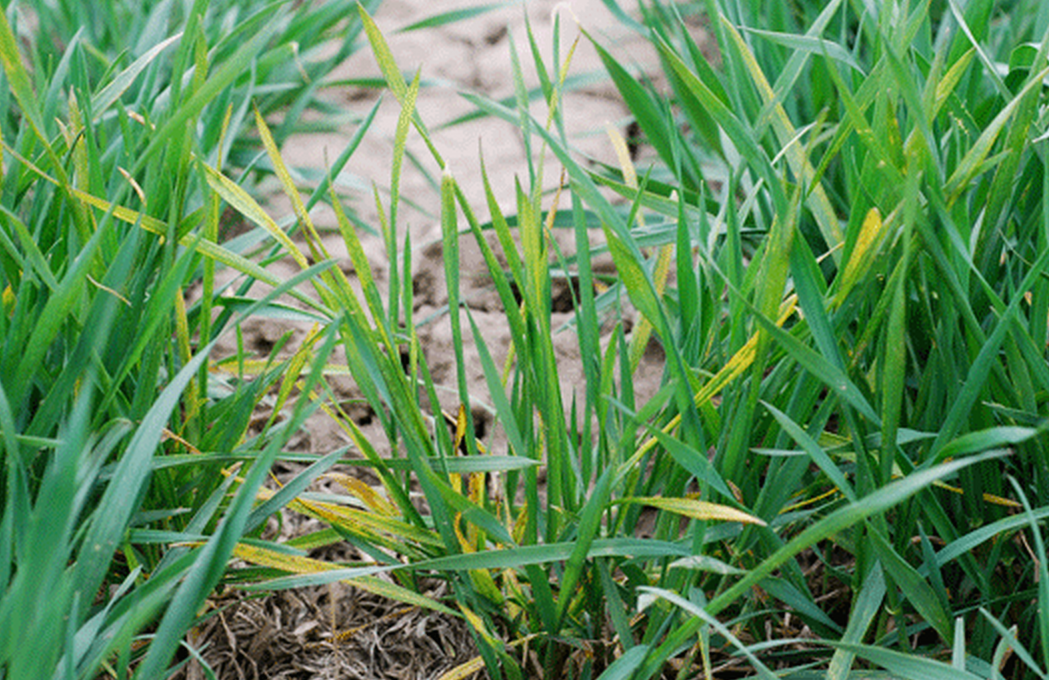Wheat streak mosaic virus is carried from volunteer to newly planted wheat by the wheat curl mite. These tiny, white, cigar-shaped mites are too small to be seen with the naked eye. The curl mite uses the wind to carry it to new hosts and can travel up to half a mile from volunteer wheat. The wheat curl mite is the vector for wheat streak mosaic, the High Plains virus, and triticum mosaic virus. In addition, the mite can cause curling of leaf margins and head trapping.
Hessian flies survive over the summer on wheat stubble. When the adults emerge, they can infest any volunteer wheat that may be present, which will keep the Hessian fly population alive and going through the upcoming crop season. We have found that Hessian flies have an adult emergence “flush” after moisture events all summer and even into November, depending upon temperatures. So it seems it is really more of a continuous potential for infestation, making it even more critical to destroy volunteer in a timely manner. If there is no volunteer around when these adults emerge they will not be able to oviposit on a suitable host plant. If the volunteer is destroyed while the flies are still larvae, this will help to reduce potential problems.
Hessian flies often cause significant damage, especially in the eastern two-thirds of the state. Hessian fly larvae attack young wheat plants near the soil line. Tillers may be stunted and later may lodge. In heavy infestations, the whole stand may be lost.
Volunteer wheat is a host of barley yellow dwarf virus, and the greenbugs and bird cherry oat aphids which carry it. So in that respect, destroying volunteer helps reduce the reservoir for the barley yellow dwarf viruses. The aphids have to pick up the BYD virus from an infected host plant first in order to become a carrier that can transmit the disease to wheat. Host plants that can carry the disease include volunteer wheat, corn, and others. However, destroying volunteer will have little effect on aphid populations in the fall and spring since the aphids migrate into the state from southern areas.
Russian wheat aphids may also live over the summer on volunteer wheat. While this insect has wings and can be wind borne for hundreds of miles, the vast majority of fall infestations in Kansas appear to originate from nearby infested volunteer.
A number of other pests are also associated with the presence of volunteer wheat. An example in western Kansas is the Banks grass mite. During some years, infestations become established during late summer and early fall on volunteer wheat. Later, as the quality of the volunteer deteriorates, mites move from the volunteer into adjacent fields of planted wheat or other small grains. Occasionally mites will survive the winter and continue to spread into the planted wheat following greenup in the spring.
A concern in the eastern part of the state is the chinch bug. Occasionally, adult bugs will fly from maturing sorghum fields in late summer to nearby fields where volunteer wheat is growing. Where infested volunteer is allowed to grow right up until seedbed preparation just prior to planting, early planted continuous wheat is likely to become infested. Similarly, volunteer that is allowed to grow through the fall and into the following spring may also serve as an attractive chinch bug host.
Another reason to control volunteer is that volunteer and other weeds use up large amounts of soil moisture. When water storage is important, such as in summer fallow, volunteer must be destroyed.
Destroying volunteer after the new wheat emerges is too late. Producers should leave enough time to have a second chance if control is incomplete. Tillage and herbicides are the two options available for volunteer control.
Tillage usually works best when plants are small and conditions are relatively dry. Herbicide options depend on cropping systems and rotations. Glyphosate can be used to control emerged volunteer wheat and other weeds during the fallow period in any cropping system. However, it has no residual activity and will not control later germinating volunteer wheat or weeds.
If glyphosate is used too close to planting time, volunteer may stay green long enough to transmit diseases and insects to the new crop. It may take as long as one week following glyphosate application before the wheat will die, so that needs to be considered when timing the application to break the bridge for insects and diseases. The optimum time to treat with glyphosate is when most of the volunteer has emerged and is healthy and actively growing. Glyphosate can effectively control volunteer wheat that has tillered.
Atrazine is a relatively inexpensive treatment for volunteer wheat control that can be applied anytime in the summer or fall, if rotating to sorghum or corn. In the September to October time period, using atrazine plus crop oil alone can often control small volunteer wheat that has not yet tillered, as well as later-emerging volunteer wheat and other weeds.
If the volunteer has tillered, most of the roots will have grown deep enough to be out of the reach of atrazine. This is when it helps to add glyphosate to the atrazine plus crop oil. Glyphosate is translocated from the leaf tissue throughout the plant. The combination of glyphosate and atrazine will provide a good combination of burndown and residual control on both volunteer that has tillered and later-emerging volunteer. Atrazine rates need to be adjusted to soil type and pH, and may not be appropriate for all areas.
In summary, the most important reasons to control volunteer wheat are:
- Wheat curl mite/wheat streak mosaic virus
- Hessian fly
- Russian wheat aphid
- Take-all
- Bird cherry oat aphid/greenbug/barley yellow dwarf virus
- Banks grass mite
- Chinch bug
- Reduces moisture loss
Taken from KSU Agronomy E-Update August 22nd, 2014.

